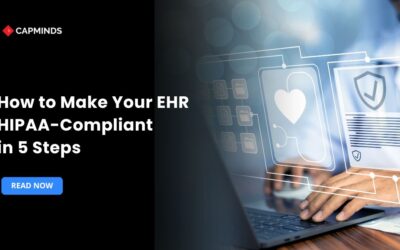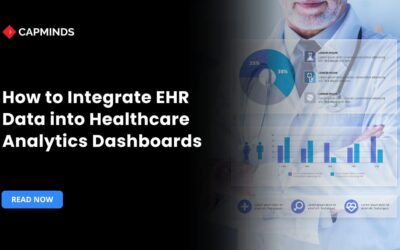Scaling to 50K Users? How to Architect a Resilient Enterprise EHR
In modern healthcare, large hospital systems and networks require electronic health record (EHR) systems that scale seamlessly while maintaining high performance and reliability. Achieving this at the 50,000+ user scale means moving beyond monolithic on-prem designs to a cloud-native architecture built on distributed, modular services.
By leveraging containerized microservices and on-demand infrastructure, a cloud-based EHR can elastically allocate resources “at the time of demand,” rather than over-provisioning for peak load. In practice, this means that each component of the EHR (for example, patient data query, order entry, and reporting) runs in its own service or container, allowing for independent scaling.
This modular design also enables rapid updates and agile responses to changing requirements (such as regulatory changes or sudden patient surges) without re-engineering the entire system.
Throughout this post, we will outline key architectural principles, including scaling strategies, security, interoperability, monitoring, identity management, and disaster recovery, that CIOs and architects must apply to ensure a robust, compliant EHR at enterprise scale.
Designing for Scalability and Performance in the Cloud
A cloud-native EHR should be designed to scale horizontally under heavy load. This means adding more instances of a service rather than only beefing up a single server.
Key strategies include:
- Partitioning the EHR into decoupled microservices (or modules) that each handle specific functions
- Running those services on managed containers or serverless platforms.
Each service can then auto-scale independently. For example, during a sudden influx of patient data, the order-entry service can spin up additional instances without impacting the authentication service.
In practice, hospitals can achieve this by putting each service behind an elastic auto-scaling group or container orchestration platform, so that extra compute nodes are added automatically during peaks.
Equally important is optimizing the database and data layer. The primary EHR database must handle both heavy read and write loads. For write scalability, the database layer should be scaled out with read replicas for reporting workloads and sharding for very large tables. This combination of indexing, caching, and horizontal database scaling ensures the central EHR datastore stays responsive under the load of tens of thousands of concurrent users.
Traffic distribution is another pillar of performance. A robust load-balancing strategy spreads user requests evenly. Typically, an active-active cluster of load balancers fronts all application servers. Unhealthy nodes are removed automatically, avoiding failures. When architecting for scale, design services to be stateless and fault-tolerant.
That is, any server instance can handle a request independently, with no long-term session state locked to a single node. This allows the cluster to handle thousands of clinicians querying or entering data in parallel.
Learn More: Expert EHR Consultation for Seamless Healthcare Integration & Optimization
Ensuring High Availability and Fault Tolerance
A large-scale EHR must be continuously available; even minutes of downtime can disrupt patient care. Healthcare organizations often target 99.999% availability for critical systems. Achieving this requires building redundancy and failover into every layer of the architecture. First, run services across multiple instances and (ideally) multiple geographic zones.
Automatic failover mechanisms are the safety net of HA architecture. It is critical to test and validate these failover procedures regularly. Document failover/failback steps and perform drills or simulated outages. Without testing, failover plans may not work in a real crisis. Practices like chaos testing (intentionally shutting down nodes) help uncover weaknesses before they impact patients.
Beyond redundancy, the architecture must avoid single points of failure. Components like load balancers or identity services themselves can be clustered or made redundant.
Healthcare’s 24/7 nature underscores the need for self-healing infrastructure. As one CIO put it, hospitals must mitigate downtime because patient lives can depend on continuous access to the EHR.
- Achieving that goal requires observability tied to automated recovery: constant monitoring (see next section) triggers orchestration workflows that replace failed instances on the fly.
- Through these measures—multi-zone deployment, redundant services, and automated failover—the system can approach “five nines” uptime even under large-scale use.
Secure, Compliant Data Handling
Security and compliance are paramount in any healthcare system, especially a distributed cloud EHR. Patient data (PHI) must be protected in transit and at rest. This means encrypting all communications (TLS/SSL for APIs and user sessions) and encrypting databases and object storage by default.
Key management must meet compliance rules: Some organizations may use customer-managed keys for additional control. In a cloud-native system, one should also isolate sensitive data using network segmentation, firewalls, or virtual private clouds.
Access controls are equally important: enforce strict authentication and authorization for any request touching PHI. Use short-lived, signed tokens (or federated identity assertions) between services to minimize risk if credentials leak. All access – whether by users or services – should follow the principle of least privilege.
Robust auditing is also mandatory: maintain detailed logs of who accessed what data and when, and regularly review them for anomalies. As one guide notes, IAM systems provide logs of all access attempts for compliance reporting and incident response.
To ensure end-to-end security, embrace a “DevSecOps” mindset. Automate security checks into the CI/CD pipeline, run container images through vulnerability scanners, and conduct regular penetration tests on exposed APIs.
Data handling procedures must comply with HIPAA (in the U.S.) and other relevant regulations: ensure patient consent and data-retention policies are enforced by the system.
Where possible, use tokenization for highly sensitive data fields, and purge data that is no longer needed (per retention policy) to minimize exposure. Continuous encryption, strict IAM, and audit trails are the core of a HIPAA-compliant, cloud-based EHR.
Interoperability and Integration at Scale
Hospitals must integrate the EHR with many other systems: laboratory instruments, imaging, pharmacy, billing, patient portals, external HIEs, etc. At enterprise scale, an interoperability strategy must use modern APIs and healthcare data standards. Expose the EHR’s patient data via secure FHIR RESTful APIs so that any certified application or partner can query records in real time.
On the inbound side, use FHIR-enabled endpoints or adapters. For legacy formats, implement interface engines or API gateways that transform incoming data into your canonical model.
This data transformation layer should normalize codes using standard terminologies so that disparate sources map consistently. A central terminology service or MPI can help match records across systems.
To handle high-volume integration, use event-driven and message-based architectures. Rather than having every external system call the EHR synchronously, publish events for common actions into a message bus or streaming platform.
Then other services can subscribe without blocking the core workflow. This decouples systems and smooths load spikes. For instance, a burst of wearable device data or bedside vitals can be queued and processed asynchronously, avoiding slowdowns in the main clinical UI.
Finally, plan for scalability in integration. If thousands of connected devices or partner clinics are feeding data, the integration layer itself must scale. This can mean sharding message queues or deploying multiple API gateway instances behind load balancers.
Caching frequent directory lookups or reference data can improve throughput. By combining standardized APIs with a scalable middleware layer and terminology normalization, the EHR can interoperate robustly as the healthcare ecosystem grows.
Observability, Monitoring, and Automated Recovery
Building a cloud-native EHR also means building full visibility into its inner workings. Observability is more than traditional monitoring: it involves collecting detailed metrics, logs, and traces to diagnose issues in a distributed system.
For each microservice, gather metrics, structured logs, and use distributed tracing to follow a patient’s request as it crosses components. Centralize this telemetry into a platform.
- Beyond raw data, invest in analytics or AIOps tools to detect anomalies.
- Monitoring alone only alerts after something has gone wrong; observability uses analysis to predict failures.
- For example, machine learning on log patterns might flag a growing error rate in the ICD-coding service before it hits the UI.
- Industry frameworks describe an observability maturity model: moving from basic metric collection to anomaly detection and automatic root-cause identification.
- Healthcare CIOs should aim for the highest level, proactive observability, where the system can often anticipate issues.
Pairing observability with redundancy creates near “self-healing” operations. A hospital EHR should be able to automatically reroute traffic or replace failed containers without clinician intervention. In practice, this means embedding health checks and auto-scaling rules at every layer.
Key observability practices include:
- Built into load balancers or service mesh to detect the failure of any component.
- All services send logs to a SIEM or log analytics; set alerts on error patterns or performance thresholds.
- Tools that trace a transaction across services, revealing latency bottlenecks.
- Scripts or orchestration policies that restart or replace unhealthy services immediately.
- Periodically simulate failures to verify that monitoring, failover, and alerting work in real incidents.
Observability is a force multiplier: it shortens MTTR and helps validate that architectural assumptions hold under stress. By continuously monitoring system health and automating failover, a large-scale EHR can achieve both high reliability and quick recovery from individual failures.
Identity and Access Management
Managing user identity and secure access is particularly challenging in a distributed EHR. The system will have tens of thousands of users, plus thousands of devices and third-party apps. To maintain security and usability, implement a centralized IAM strategy with these principles:
1. Robust Authentication
Require strong login methods for all users. Implement multi-factor authentication for clinicians accessing PHI to add security without excessive friction.
As one analysis notes, MFA and single sign-on together “minimize the risk of unauthorized access” while streamlining workflow. A single sign-on portal allows users to log in once and access all EHR modules and integrated apps seamlessly, improving efficiency.
2. Role-Based Access Control
Define roles with precise permissions. Each user is assigned a role according to their job and inherits all rights of that role. For example, a nurse’s role might permit viewing and entering progress notes but not modifying billing records.
This simplifies management and ensures the principle of least privilege is followed. Detailed audit trails should record every access, for example, who viewed or edited a patient record, to support accountability and compliance.
3. Federated Identity and Zero Trust
In a modern hospital network, identity becomes the new perimeter. Use identity federation to allow secure access across multiple domains.
Adopt a Zero Trust mindset: continuously verify that each request is allowed, rather than trusting internal networks by default. For instance, clinical staff devices could be profiled and validated each session, even within the network.
4. Provisioning and Deprovisioning
Automate user lifecycle management. When an employee is hired, provisioning should grant them access to all needed systems quickly, and when they leave, all access must be revoked immediately.
Unused accounts should be disabled automatically after inactivity to prevent old credentials from being exploited. As one IAM guideline notes, “IAM systems simplify the process of assigning and removing access rights” to prevent unauthorized carryover.
5. Audit and Monitoring of Access
Continuously monitor login attempts and access patterns. Alert on suspicious behavior to detect compromised accounts. IAM logs should feed into the overall observability stack. Regular access reviews help ensure that permission sets remain aligned with current roles.
By centralizing authentication and enforcing RBAC at scale, the EHR stays secure even as the number of users grows into the tens of thousands. This protects patient data and helps meet regulations like HIPAA, which require strict access controls and logging.
Disaster Recovery and Business Continuity
Finally, no architecture is complete without a solid Disaster Recovery and Business Continuity plan. In healthcare, an unplanned outage isn’t just an inconvenience – it can halt patient care. Therefore, plan for the worst: natural disasters, data corruption, ransomware, or major outages. Key steps include:
1. Define RTO and RPO
Establish Recovery Time Objectives and Recovery Point Objectives (RPO) for the EHR system. For example, determine the maximum acceptable downtime and how much recent data loss is tolerable for the hospital. Typical targets might be in the minutes to low hours range. The cloud can help meet aggressive RTO/RPO, but they must be explicitly set.
2. Multi-Region Replication
Replicate data and services across geographically separate locations. In practice, this means running data replication to a DR site in a different region or cloud. For databases, use cross-region replication so that if one region fails, the secondary has an up-to-date copy. Automated scripts or Infrastructure-as-Code should allow provisioning a full copy of the environment in the DR region if needed.
3. Regular Backups and Air-Gapping
In addition to live replication, maintain periodic backups of data (including encrypted snapshots of databases) stored in an offline or alternate location.
This protects against data corruption or ransomware, where the live replicated data may also be compromised. Air-gapped backups ensure you can restore original data even if production is infected.
4. Test and Drill
Regularly simulate failovers and perform restore drills. For example, practice switching to the DR environment to verify the plan. As experts warn, stress-testing is key: without regular testing, you risk discovering problems only during a real crisis.
Conduct “tabletop” drills with the operations and leadership teams to walk through roles and checklists for various scenarios. Document detailed runbooks: who does what, and in what order, if systems go down.
5. Automation for Fast Recovery
- Use automation wherever possible. Infrastructure-as-Code can rebuild servers and networks quickly.
- Automated failover scripts can detach broken infrastructure and bring up fresh instances.
- By using code to define the environment, you reduce human error and speed up recovery.
- For example, continuous replication tools or cloud DR services can replicate data nearly in real time, minimizing RTO and RPO.
6. Business Continuity Planning
Plan for operations even if IT systems are offline for a time. Have documented emergency procedures so critical care can continue. Assign roles in advance.
The cloud inherently simplifies parts of DR – for instance, well-architected frameworks and managed backup services – but the team must still plan and practice.
As one health IT leader notes, failure to craft a strong BCDR plan can lead to catastrophic downtime and data loss. With a complete DR strategy, an enterprise EHR can recover quickly and maintain continuity even under severe disruptions.
Related: Why Backup & Disaster Recovery is Now a Board-Level Priority for Health Systems
Unlock Enterprise-Grade EHR Success with CapMinds
At CapMinds, we empower healthcare organizations to scale securely, efficiently, and intelligently with our robust digital health tech solutions.
If you’re aiming to serve 50,000+ users with an enterprise-grade EHR platform, we offer everything you need to build and maintain a high-performance, cloud-native system.
Our services are tailored for large-scale, modern healthcare environments:
- Custom Cloud-Based EHR Development with microservices architecture
- High-Availability Infrastructure with auto-scaling, multi-region failover & disaster recovery
- FHIR-Compliant API Integrations for seamless interoperability
- Identity & Access Management solutions for secure, role-based access control
- DevSecOps & CI/CD Automation for agile, secure deployments
- 24/7 Monitoring, Observability, and Automated Recovery Systems
CapMinds is your trusted partner in building resilient, secure, and compliant health IT infrastructure.
Let us help you future-proof your EHR ecosystem for scale and success.




